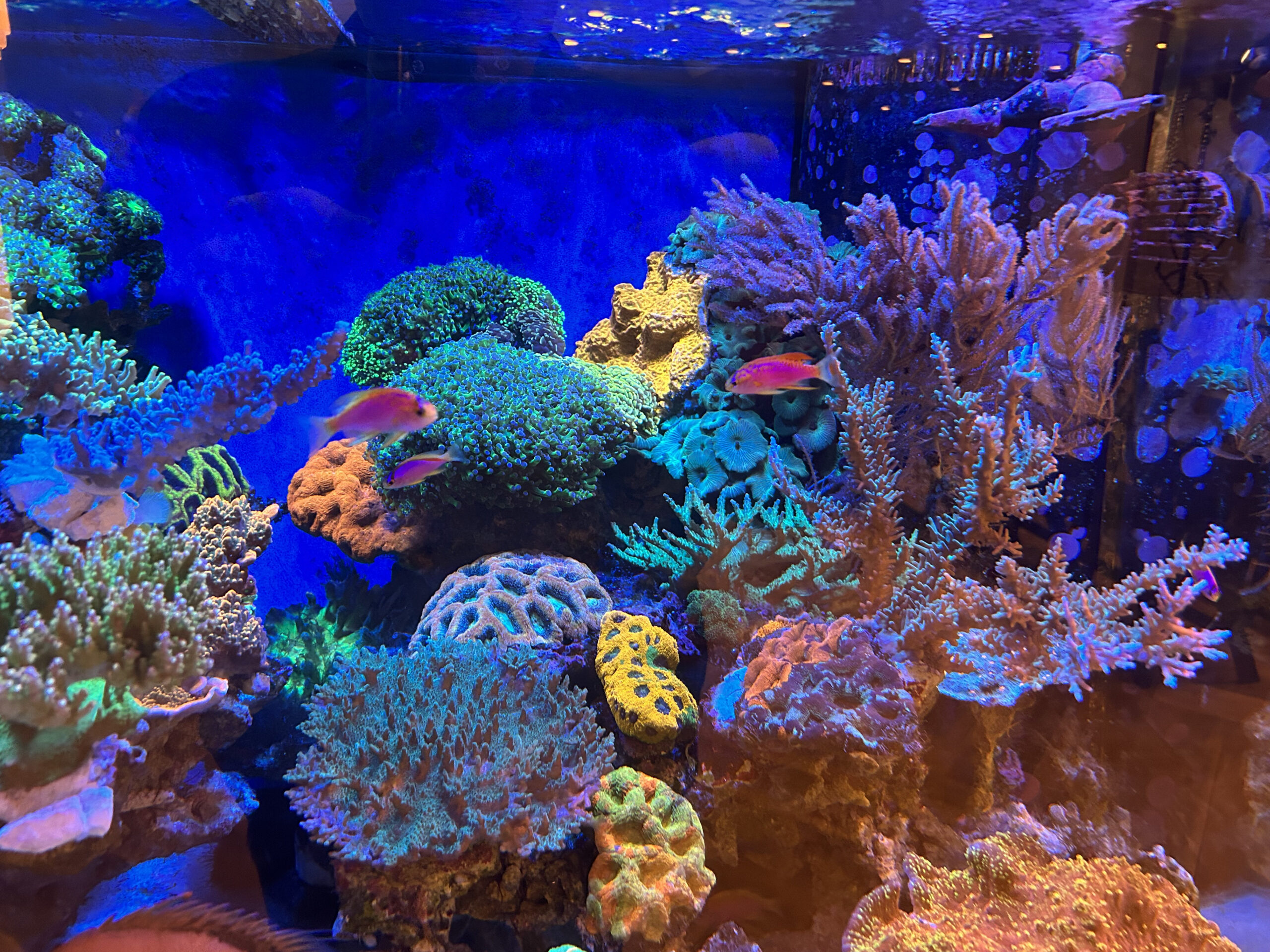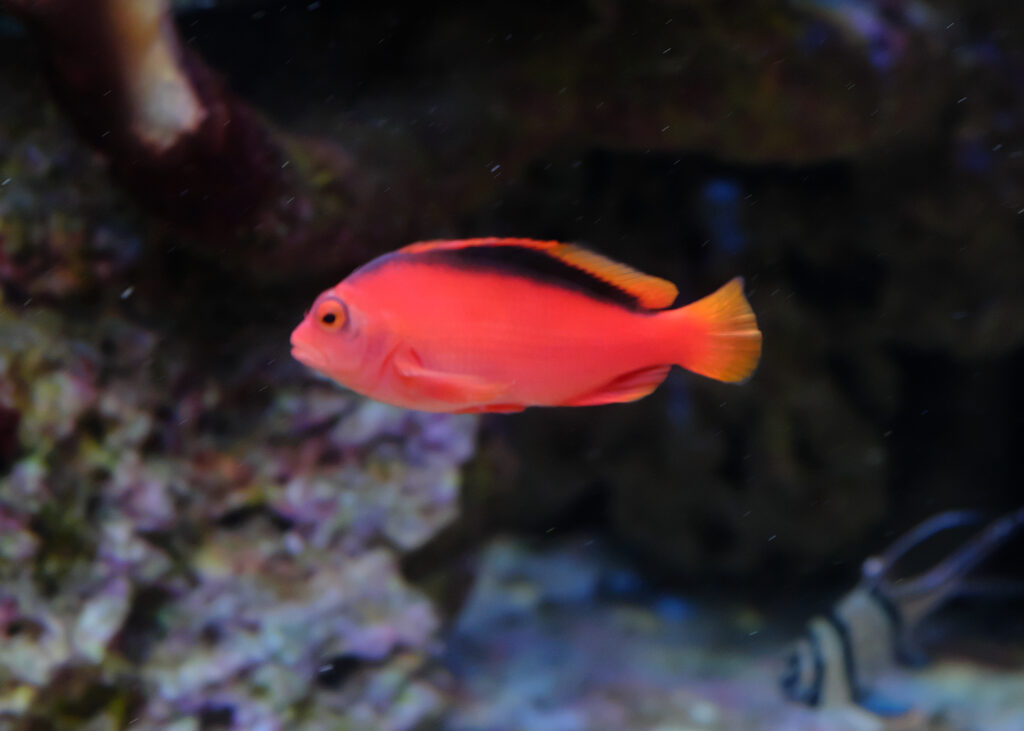Quick Facts 
Scientific Name: Odonus niger
Other Names: Red tooth triggerfish, Red fang triggerfish, Blue triggerfish, Red toothed filefish
Reef Safe: No
Lifespan: 10 years
Size: 12 inches
Care: Easy as long as they have enough space to swim
Diet: Carnivore
Water Conditions: 72 to 82°F, 8.1 to 8.4 pH, 8 to 12 dKH, 1.020 to 1.025 SG
Tank Size: 100 gallons
Behavior: Aggressive
Breeding Difficulty: High
We like the Niger Triggerfish because it is a beautiful and popular saltwater fish that is known for its bright colors and aggressive personality, so we are sure you will enjoy having it in your aquarium.
These fish require a large tank with plenty of space to swim and should not be kept with other fish that are smaller or weaker than them. This guide will provide you with this and more information essential to successfully care for you Nigger Triggerfish so let’s get started!
Species Summary
The Niger Triggerfish also known by its scientific name as Odonus niger is a mischievous, spitfire of a fish that is prized for its beautiful coloring and lyre-shaped tail.
When divers encounter this tropical fish in its natural habitats throughout the waters of South Africa, the Great Barrier Reef, New Caledonia, Fiji, and Indonesia, they know that these triangle-shaped beauties have a reputation for charging at divers with their chompers!
Author Note: This reputation for vivaciousness and aggression is something that potential Niger Triggerfish owners should keep in mind. While this isn’t the most beginner-friendly fish, the right accommodations can make ownership relatively breezy.
The fun of getting to know the distinct personality of a specific Niger Triggerfish can also be a very exciting aspect of ownership with this species. The Niger Triggerfish is sometimes called the Redtoothed Triggerfish or Blue Triggerfish.
Appearance
Pinning down the color of a Niger Triggerfish can be tricky because this species can actually change color based on its mood! The easiest way to describe the Niger Triggerfish is to call it a blue-green fish. However, you may also see hints of black, purple, and some softer hues thrown in the mix.
The red teeth of the Niger Triggerfish can be quite jarring to see! These little “fangs” are as sharp as razors! In fact, these fish work hard at maintaining their pointed teeth by continuously gnawing on coral rubbles, crustaceans, and sponges. It is important to note that just a few of these triggerfish don’t develop red fans.
In addition to a distinctive lyre-shaped tail, these fish also have small pectoral fins. Pelvic fins are notably absent on these fish. As a result, they can be seen steering their bodies in the water using their anal and dorsal fins.
Lifespan
A Niger Triggerfish can be expected to have a lifespan of 10 years if it’s properly cared for in a tank environment. It’s not unheard of for these fish to live up to 15 years.
Average Size
The average size of a Niger Triggerfish is 12 inches. Larger ones could grow as long as 18 inches.
Triggerfish Care
The main thing that a Niger Triggerfish wants is space. These are active fish with a strong desire to spend their days exploring sand and rocky shoals for signs of food. In addition to space for swimming, Niger Triggerfish appreciate some hiding spots for rest.
Author Note: It’s very important to create ideal conditions for this fish because a stressed Niger Triggerfish is an aggressive Niger Triggerfish. Tank mates are in danger whenever this temperamental fish doesn’t get exactly what it wants!
Tank Size
A Niger Triggerfish requires a tank that’s at least 100 gallons in order to be able to move around freely and happily. If possible, aim for 180 gallons per triggerfish to provide the space this species needs for absolute contentment!
Water Parameters
- Water temperature: 72to 82°F
- pH levels: 8.1 to 8.4
- Water hardness: 8 to 12 dKH
- Specific gravity: 1.020 to 1.025
Tank Setup
Niger Triggerfish can spend hours exploring the sand for signs of “sunken treasure” food particles. Niger Triggerfish also like rock structures that provide hiding and resting spots when they’re not exploring the bounds of the tank. Space rock structures appropriately to avoid crowding the tank. With Niger Triggerfish relying on their fluttering dorsal and anal fins to get around, they need plenty of open space to move comfortably.
Additionally, these fish are notorious for turning rocks over to search for buried food. They are also big waste producers for their size. Upgrade to a stronger filter to keep up with the ongoing mess! In case you were wondering the size of the filter, just go with 4 to 6 times the volume of the tank. See examples in table below.
| Tank Size | Minimum Filter Flow Rate | Best Filter Flow Rate |
| 30 gallons | 120 gallons per hour | 180 gallons per hour |
| 50 gallons | 200 gallons per hour | 300 gallons per hour |
| 100 gallons | 400 gallons per hour | 600 gallons per hour |
Author Note: While many fish need lidded aquariums to prevent jumping, Niger Triggerfish require lids for a different reason. As infamous splashers, these fish will create a real mess around an aquarium if there’s no lid to keep the ripples contained.
The Niger Triggerfish doesn’t have any ultra-special lighting requirements. It’s just necessary to keep the aquarium on a daylight cycle while the triggerfish is sleeping at night. It can be fun to play with different lighting modes to bring out the different hues in the scales of this fish.
Are Niger Triggerfish Reef Safe?
No, Niger Triggerfish are not generally reef safe. Even though they do not eat corals, the problem is that they may use coral rubble to sharpen their famous red fangs. They’ll also use sponges, snails, tunicates, and any crustacean they can access to polish their teeth.
Another challenge is that Niger Triggerfish have the habit of turning over rocks and other tank decorations which can cause chaos for corals. You might be surprised to learn that all these issues occur during adulthood since as juvenile they are not that problematic (just as humans, right?)
With that said, many tank owners have figured out a way to get their Niger Triggerfish to coexist with corals. This could be by providing plenty of space, a great diet and friendly tankmates but if you have expensive coral, maybe think twice before adding a niger triggerfish to your tank.
Common Possible Diseases & Prevention
The Niger Triggerfish’s body is coated in a film that protects against parasites. In fact, this film is one of the reasons why this fish glides so gracefully through the water! This added bit of protection doesn’t mean that the Niger Triggerfish is impervious to illness and disease.
Niger Triggerfish are vulnerable to bacterial infections. The biggest risk factor for infection is actually tank upkeep. Poor water quality, low oxygen, and improper salinity can all put this fish at risk for infection.
Author Note: The telltale sign that a Niger Triggerfish is afflicted with a bacterial infection is the appearance of white spots on the belly, mouth, and other areas of the body. There’s usually a hunger strike that accompanies these visual symptoms because infection causes a loss of appetite in Niger Triggerfish.
As famously moody fish, Niger Triggerfish are prone to depressive episodes. Depression can strike a fish due to boredom, lack of hiding spaces, lack of freedom to roam, or an unsatisfying diet. Depressed Niger Triggerfish will act lethargic, become aggressive, or simply stop eating. If a Niger Triggerfish’s fangs are looking overgrown, this is a sign that the fish is not being provided with a proper diet full of hard, meaty objects.
Food & Diet
As active fish, Niger Triggerfish do best when they are being fed a carnivore diet two to three times per day. Variety is also important! Make sure to alternate their carnivorous preference with some planktivorous options such as algae based foods and pellet supplements.
Never forget to include foods that will help them wear down their teeth. Niger Triggerfish will grow stressed and agitated if they are not able to trim their teeth naturally.
A few options include:
- Krill
- Mysis shrimp
- Mussels
- Brine shrimp
- Squid
- Clams on the half shell
Behavior & Temperament
The aggressive reputation of the Niger Triggerfish is deserved. Known for their aggressive and territorial temperament, these fish will chase and pick on smaller, timid fish.
Providing the Niger Triggerfish with plenty of hiding spots is a great way to reduce aggressive behavior. In addition, giving this fish extra space can promote a calmer demeanor to back off from attacking weaker tank mates.
Niger Triggerfish Tank Mates & Predators
As aggressors, Niger Triggerfish should be kept away from smaller fish that are considered vulnerable or timid. Keep them away from clams, shrimp, crabs, and other tank mates that could be very easy to pick off.
It’s also recommended to keep Niger Triggerfish away from tanks with Clownfish and similar species simply because the potential for violence is “iffy.” Here’s a list of tank mates that often work quite nicely with Niger Triggerfish:
Author Note: The goal is to essentially pair Niger Triggerfish with fish of similar sizes and aggression levels. It is also possible to keep more than one Niger Triggerfish. With odd numbers being ideal, keeping three of these fish in the same tank creates a sweet spot for getting along.
Is Breeding Niger Triggerfish Difficult?
Yes! Breeding Nigger Triggerfish is not impossible but it is very difficult. In the wild, these fish will find their way to mating grounds in schools. In tanks, the female will lay eggs in a nest after being courted by a male. The male will then guard the nest as he waits for the eggs to hatch.
Once they make their debut in the tank, the baby fish will need to be fed specialized larvae before graduating to meatier foods. Therefore, there’s no way around the fact that successfully breeding Niger Triggerfish is difficult.
Another obstacle is that distinguishing between male and female is very challenging. Niger Triggerfish don’t have an external way to properly identify the sex of this species. There’s also the challenge posed by the fact that newly hatched fish require the pH to remain within the recommended range, so any deviation from the aforementioned parameters could lead to failure.
This is probably why most of the aquarium nigger triggerfish are wild caught.
Conclusion
We hope you enjoyed reading this care guide as much as we enjoyed writing it. Niger Triggerfish are a great option to add to your aquarium due to their bright colors and interesting personality.
Don’t forget to do regular water changes because they are known to be messy eaters and to provide them with a variety of hiding places, such as rocks, caves, and coral.
If you are looking for other fish from the Balistidae family try the Clown or Picasso triggerfish, and don’t forget to tag us on Facebook when sharing a photo in social media of your Niger Triggerfish. If you need anything feel free to reach out to us and we wish you best of luck!



